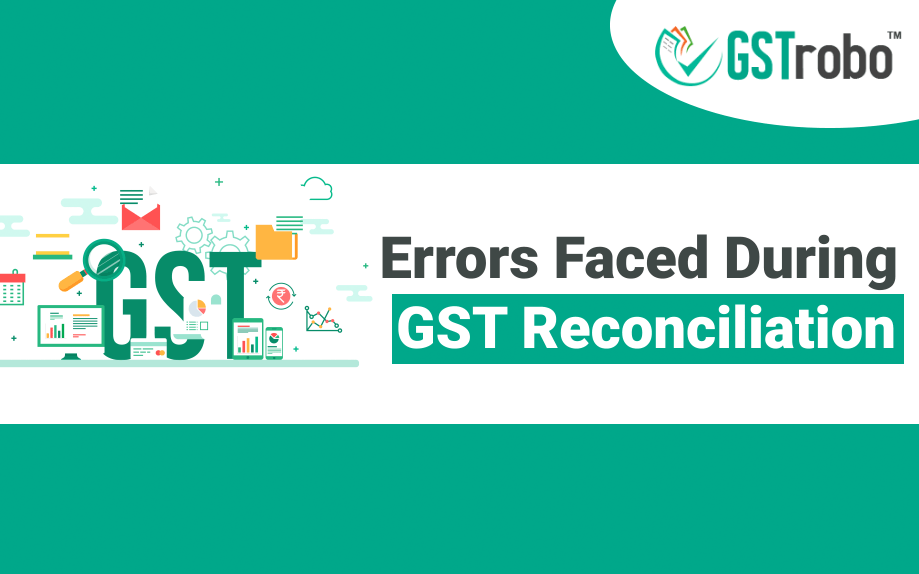Errors Faced During GST Reconciliation
Just like getting the right GST software that integrates with your ERP ensures efficiency and no revenue loss, similarly, reconciling your returns with that of the supplier helps you to claim accurate Input Tax Credit. So, it is important to know the errors faced during GST reconciliation:

What is GST Reconciliation?
Reconciliation under Goods and Services Tax (GST) is matching the data furnished by the supplier with those of the recipient and recording every transaction that has been missed during the taxable period. The reconciliation ensures that no sales or purchases are precluded or wrongly detailed in the GST returns.
Errors Faced During GST Reconciliation
Here is the list of errors faced during GST reconciliation by a taxpayer:
- Not Present in GSTR-2A
Not present in GSTR-2A is one of the major errors that you may face during GST reconciliation. This error happens when you record a transaction detail in your purchase register, but the supplier misses the same transaction while filing GSTR-1 (the data of GSTR-1 auto-populates GSTR-2A)
- Not Present in Purchase Register
This is another major error that you may encounter while carrying out the GST reconciliation process between the purchase register and GSTR-2A. As the error name suggests, there can be instances when you forget to record a transaction, but your supplier has recorded it in his GST return.
- Invoice Date Mismatch
There can be chances that the date mentioned in the purchase register is completely different from the invoice date mentioned in the GSTR-2A.
- Invoice Number Mismatch
An invoice number mismatch error happens when there is a discrepancy between the invoice number mentioned by the supplier and the purchase register. Typically, this happens due to different methodology of the recording invoice number. For instance, you furnish invoice number GST01-2021 in your purchase register and the recipient records it as GSTINV-01.
- Place of Supply Mismatch
There can be instances when their place of supply mentioned by you in the purchase register does not match with the GSTR-2A data. For instance, you have 2 business units, UP and Delhi. You purchased raw material for the UP unit but instead of this supplier mentions the GSTIN of the Delhi unit.
- Invoice Value Mismatch
Mismatch in the invoice value is the most common error faced by a taxpayer. Generally, this happens due to different rounding-off methods used by the supplier and recipient.
- CGST and SGST Mismatch
CGST and SGST mismatch errors are not so common but this happens when the supplier has recorded the supply as interstate supply instead of intra-state supply in his GSTR-1. In simple words, your GSTR-2A is reflecting IGST instead of CGST and SGST.
- IGST Mismatch
Error in IGST mismatch happens when the supplier has recorded the supply as intra-state instead of inter-state in his GSTR-1. In other words, when your GSTR-2A is reflecting CGST and SGST in place of IGST.
- CESS Value Mismatch
There can be a minor mismatch in the CESS value mentioned by you in the purchase register and GSTR-2A due to a different rounding-off method.
- Note Date Mismatch
Note date mismatch is a very common error, in this error the note number in purchase register and GST returns are similar. However, note date differs in purchase register and GSTR-2A.
Way Forward
There are two ways by which you can reconcile the above-mentioned mismatches
- Manual Reconciliation
Whenever you find a Mismatch, you contact your supplier to make amendments to his/her GST return. However, it will become a herculean task when there are hundreds of mismatches.
- Reconciliation Through GST Software
This method will help you to auto-reconcile all the mismatches and in case of errors, you can notify your supplier through a single click. GST software automates your reconciliation process, thus saves your time and compliance costs. GSTrobo® has established GST software with the state-of-the-art-technology that not only seamlessly integrates with ERPs but also helps in claiming 100% accurate input tax credit (ITC) by reconciling all the discrepancies.
